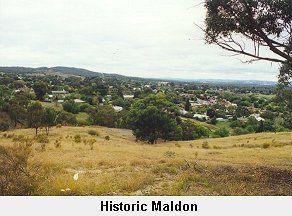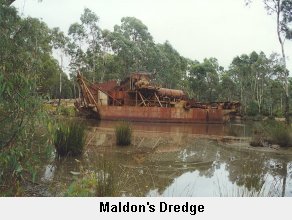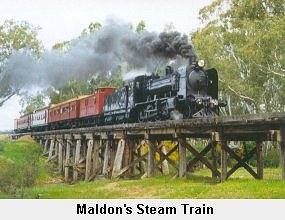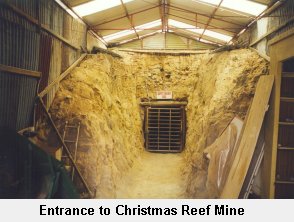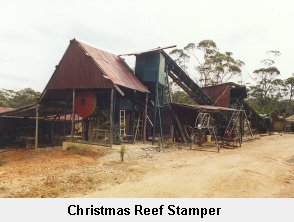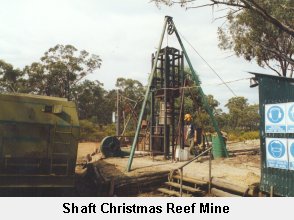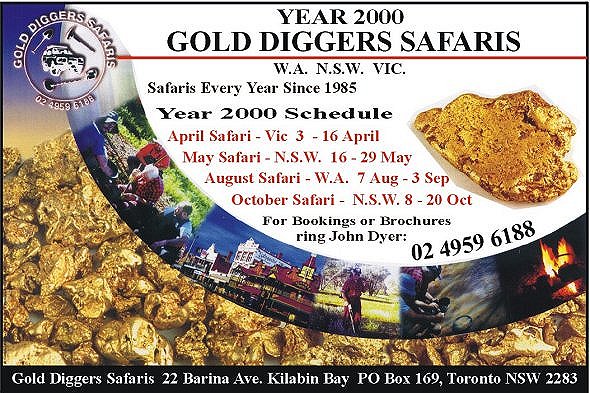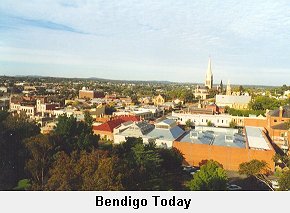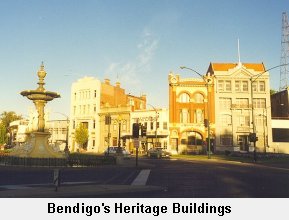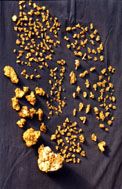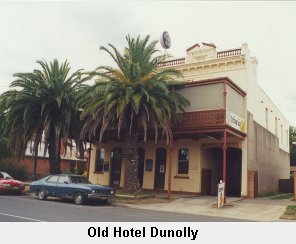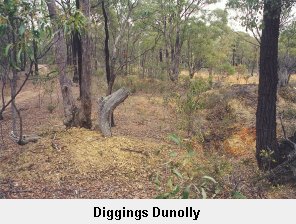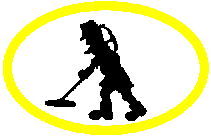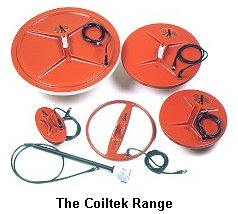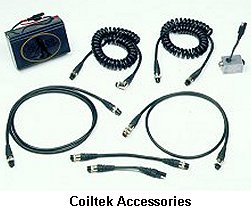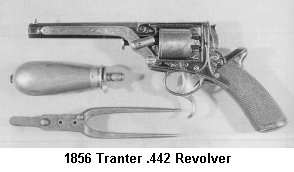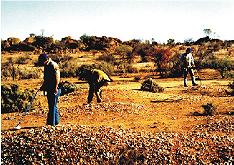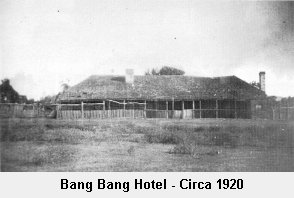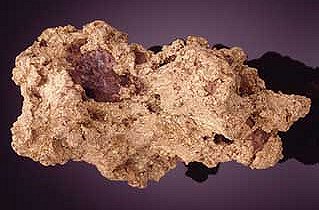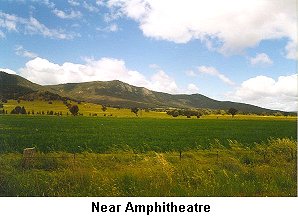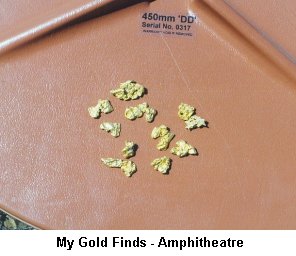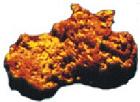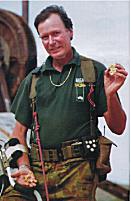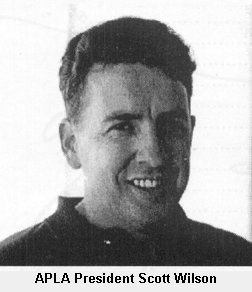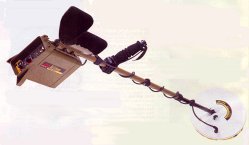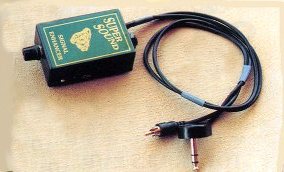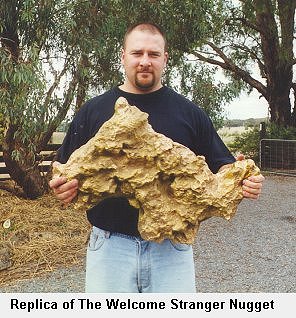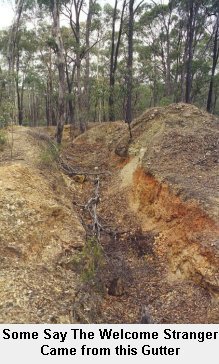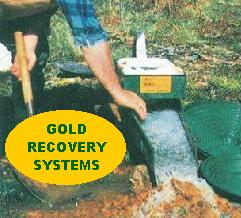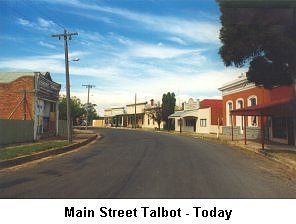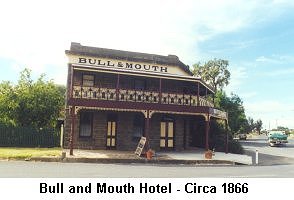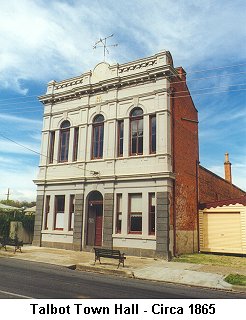
| April 2000 | |||||||||||||||||||||||||||||||||||||||||
|
|||||||||||||||||||||||||||||||||||||||||
Contents
|
|||||||||||||||||||||||||||||||||||||||||
| 1. EDITORIAL Just where is the price of gold going? That is a vexed question and one that continues to stimulate debate world wide. The buoyant stock markets world wide have in recent weeks suffered set backs with wild fluctuations, showing losses and then recovery, with E Trade stocks being particularly volatile. The question remains. Where does gold now fit in world commodity markets? It is extremely difficult to assess and make positive predictions with so many conflicting indicators. With European governments continuing to sell off tons of gold this action assists in destabilising and suppressing gold market prices world wide. With gold now a low US$ 280 or thereabouts - is it any wonder that gold mines are closing around the globe. This is certainly the case in Australia, with more closures imminent. In selling off their gold reserves, the UK Government has been roundly criticized from all quarters. Reducing their gold reserves to just 7% of domestic reserves appears to be economic madness. The havoc that actions of this nature create, are felt world wide and do untold economic damage. We can but hope that gold will reassert its real place in world markets and soon. The article relating to Gold Net Directions has been held over - as negotiations continue behind the scenes.
Email: [email protected] All material in this magazine is copyright and may not be reproduced in any part or form whatsoever without written permission from the publisher.
|
|||||||||||||||||||||||||||||||||||||||||
|
2. MALDONS MILLIONS by Chris Theyer Nestled in gentle slopes in a small outcrop of hills the historic town of Maldon lies almost undisturbed by modern man. Without the electricity poles and the modern vehicles this town could still be taken as a gold town of the 19th century. It is a quaint little town, with tree-lined streets and abundant greenery that adds to the warmth and welcoming aura of this grand little gem of the golden era. The step back in time is clearly evident as one drives into the town and into the past.
20,000 diggers found their way to Maldon for the gold rush here in 1853, but within a year only 2,000 remained, the majority moving onto richer pickings.
About 1.5 miles south of the town is "Carman's Tunnel," a mining tunnel constructed from 1882 and 1884 driven through solid rock in search of gold is well worth the time.
Porcupine Township on the Bendigo Road, is another place that is well worth a visit. An "olde" gold town if ever there was one. The Museum in the Town Reserve is full of information and relics of the past. Photos abound and although only open on Sundays from 1.00pm it is well worth a visit.
In the centre of Maldon is an area designated an Historic Precinct, and within this compact space there are many rambling old buildings that can be investigated with ease and in comfort. There are lots of quality eating places and al fresco diners and of course the obligatory hotel, well there are three actually.
In recent years an huge open cut mine to the north of the town has been operating recovering good gold, but recently with the gold price collapse, all mining activities have ceased. The Alliance Mining Company undertook a massive revegetation program when it took over the open cut mining operation, restoring large areas with revegetation programs. Just a little east of the town on the Bendigo Road is a large steel dredge accompanied by a huge dragline, attached to a rather large steel tracked contraption. Well it looks like a large crane - sort of. What clearly comes to the fore with all the gold memorabilia that abounds in this little historic town is that gold was prolific and certainly plentiful - wherever you look. A large chimneystack dominates the skyline to the east of the town. The remains of the Beehive Mine site are in this spot and clearly the workings here were extensive. The workmanship in the brick stack is a marvel of engineering excellence and is well worth close inspection. Maldon is indeed a gem in a magnificent place on this earth, and I can thoroughly recommend a visit to this most historic town. There are just millions of things to do in Maldon.
|
|||||||||||||||||||||||||||||||||||||||||
|
|||||||||||||||||||||||||||||||||||||||||
|
|||||||||||||||||||||||||||||||||||||||||
|
|||||||||||||||||||||||||||||||||||||||||
|
3. THE CHRISTMAS REEF MINE by Laurelle Murphy
Gold nuggets at Wedderburn were plentiful and large, and even today good quality large nuggets are still being dug from the ground here, in particular at Queens Gully, Beggary Hills, and Hard Hill. Ironically in the 1950's, a small rush occurred here with the finding of several large nuggets, but it was short lived. The Christmas Reef was located about 4 miles east of the present town, and was worked with some success in the latter part of last century, after which the mine site fell into disrepair, and almost faded into obscurity.
The Christmas Reef Mine was certainly mined with zest in the latter part of the 1800's but apparently the reef was lost and despite several attempts to relocate the reef all were unsuccessful. The reef generally ran north south as do most of the gold reefs throughout the gold fields, and it was followed and tried on several occasions to relocate the main reef once again with no success. The indications were always good - but the reef remained hidden, and remains that way to this day. During the mining operations carried out by the McGuires, they criss-crossed the area where the old reef had been worked, both above and below where the reef concluded as indicated by the old workings. Although Doug and Ann were able to recover some gold it was not to be their Eldorado that perhaps still remains to this day hidden in the surrounding ground. Early in the 1990's a public company was floated with the object of raising capital to further develop the mine, but that exercise appears to have been somewhat unsuccessful, and no work of any note was undertaken to develop the mine further. Unfortunately Doug McGuire suffered a major heart attack about 4 years ago and passed away. Doug was certainly a character, and was building the tourist side of the business quite well when he passed away.
This is no longer a full time pleasure as other income is earned by keeping bees and cutting timber for wood fires. This both supplements the small income from gold and provides the staples of life, and allows moderate development towards the old reef. Well at least that's the idea. Noting the way that both Robert and Terry are pursuing their goal, if there is any reef left they are sure to find it. Each day the shaft is worked, at least one member climbs down into the work area and shovels the broken shale into a 44-gallon drum. By air pressure it is then forced to the surface, by an ingenious contraption that incorporates a huge compressor that incorporates an old Studebaker wartime vehicle that acts as an emergency brake on the drag line, utilising the power winch attached to the front of the vehicle. Once the shale is on the surface it is placed on a small, railed cart fitted with a frame that is almost balanced midway allowing the drum to be easily manipulated and the shale stored nearby out of the way.
The Christmas Reef Mine also displays a great deal of memorabilia in the Bark Hut Museum. This structure is modelled on the buildings that were constructed by early settlers using local Stringy Bark and Iron Bark timbers. A grand array of antiquities is housed in this structure. In the past the mine site has been used as a training site for Tertiary and Further Education relating to mining operations in Victoria, and it is anticipated that this facility will be restored in due course. The old stamper, a rather large structure of a bygone era still works effectively and provides a very practical demonstration of how the gold was won in times gone by.
Tuition for would be detectorists is provided for the enthusiasts and hire of detectors is encouraged from Barrie Johnson Detector Services in the town of Wedderburn. There are BBQ and camping facilities, which includes a toilet and shower block.
|
|||||||||||||||||||||||||||||||||||||||||
|
|||||||||||||||||||||||||||||||||||||||||
|
|||||||||||||||||||||||||||||||||||||||||
|
|||||||||||||||||||||||||||||||||||||||||
|
4. BENDIGO'S BENEVOLENCE by David Haigh If one is intent on locating just where the gold came from in the Golden Triangle of Victoria it is most interesting to take the time to investigate where the most gold was recovered from throughout this fabulously wealthy area. If you are a detectorist it is vital that your investigate carefully just where the gold was found, or you will spend many unproductive hours wandering the area without reward. Most would not recognise the significance of the great gold feast that came from Bendigo, as this area is head and shoulders above all others. Don't be drawn into the trap that Ballarat was the great gold feast of last century as this was not the case. Ballarat was certainly a catalyst for events in the gold fiends, such as the Eureka Stockade stand, and today a leader in tourism in Victoria with the historic village of Sovereign Hill, www.sovereignhill.com.au coupled with the nearby Australian Gold Museum, and the Eureka Stockade exhibition. But in gold terms Bendigo's contribution is a stand alone effort. In fact the gold recovered from Bendigo is more than over 754 tons and that was only the amount officially recorded. Ballarat recovered just 177 tons from official records. No other place in Victoria comes near Bendigo in gold recovered.
Gold was so plentiful in Victoria in the early 1850's and there were so many rushes in the Ballarat, Castlemaine and Maryborough regions that Bendigo was one of the last areas to be rushed. In 1851 the first rushes occurred here at Ironbark Gully, Peg-Leg Gully and Golden Gully. There were only just over 600 diggers here at Christmas of 1851, and they all joined in pooling their food resources for a grand Christmas dinner that year. The resident gold commissioner here reported that three diggers had recovered over 48 lbs. of gold from one dish load through a cradle. He further reported that two diggers had recovered 7lbs. of gold in one morning and these two had previously sent 75 lbs. of gold to Melbourne previously. He later reported that in resolving a dispute he had to draw a line on the ground with his knife pushing the gold to either side of the line as the knife moved forward, reporting that the gold was as thick as plums in a Christmas pudding. So plentiful was the gold, that the average get in such places as Ironbark and Eaglehawk were from 3 to 4 ounces per man per day.
The gold recovered was escorted to Melbourne under escort, and it was reported that for close to three years at least two ton of gold was transported twice every month on average during that time, and it should be remembered that this was only the disclosed gold. Presumably, at least that amount again was taken from this golden place, by other means.
Bendigo today is a grand rural city. A thriving economy supported by rich rural pursuits, including among other things, cattle, fat lambs and wool production as well as crops of all types, including wheat, barley, oats, lupins and faba beans. Many other boutique industries, such as alpaca, emu and ostrich breeding and all strongly supported here.
|
|||||||||||||||||||||||||||||||||||||||||
|
|||||||||||||||||||||||||||||||||||||||||
|
|||||||||||||||||||||||||||||||||||||||||
|
|||||||||||||||||||||||||||||||||||||||||
|
5. GOLDEN HOLIDAY DOWN UNDER - Part 2 by Gus Boyd I slept like a log that night - it was a queen size bed and I can't even remember hitting the pillow. At the appointed time though I was up and ready to roll, into the "real" gold fields. David was in fine form this morning and as we travelled along heading west he was giving me descriptions of the areas as we travelled through them, mainly referring to the old gold sites from years gone by. Most of the country is now grazing and cropping land with stretches of what David described as "scrubby bush". Eucalypt forest spreading for miles in areas designated as State Parks. There were plenty of diggings along the side of the road if you looked, and I wondered why we were not stopping there. It was explained to me that all and sundry had been there before and most of the easy gold had been taken from these areas.
Then on towards Dunolly, on quite a good bitumen road. I was surprised that the roads were so well made in fact, as I had not expected this to be the case. This little town is not much more than a main street with a couple of back streets with a few strewn about mean dwellings. The buildings here were old. Two large imposing two story hotels and old shops lining the main street, and seemed to stretch for a couple of miles. As I was informed the main street of Dunolly used to run for 3 miles when the gold rush was on, it was understandable that it still somehow resembled an old gold town. The old shops were very old indeed and many were in need of repair. There is a large trailer park here with a good clientele who, I was told regularly visit the nearby gold fields.
It was here that we visited John Harding, an old Aussie character that turned out to be a wealth of information. His knowledge of gold and in particular this area was exceptional. I could have talked to him all day, but no, David was insistent that we head for the gold fields proper. North of the town there is a large area of State Forest, and in these forests one can detect to your hearts content. We headed out to an area called "White Patch" and started there.
I decided that going after the large nuggets could be David's domain, and I changed back to a smaller detector head. Slipping on the small elliptical coil, I was soon picking up small nuggets in a rather unlikely looking gully. They were not big but I was having a ball. A nice little collection was being gathered and I noticed that David too has swapped back to a small coil.
We had a delightful afternoon out here. It was warm, pleasant, and I was getting gold. I was amazed at just how much energy I found to dig up those little pieces of gold. I must say though that I did dig up a fair bit of junk too, but that was clear evidence that this had been a pretty fair gold field in the past. Close to 5pm I was pretty well shot and ready to take a rest. I had really enjoyed the day and found my host to be a delightful and affable "bloke", as the Aussies say. When we got back to the hotel, David came into the bar with me and we had a few drinks. I rather liked Aussie Beer. Almost too much, as I had more than I would normally consume, but the company and the stories were good, so I stayed and enjoyed a pleasant evening with mine host. I stayed in this area for a few more days - detecting and talking to like minded folks I found in the "bush", and at the motels and hotels I stayed at. It would be fair to say that I didn't find my bonanza, but I did find gold and so thoroughly enjoyed this place. The characters I came across were many and varied. Some perhaps braggarts, other very humble, and yes there were a couple of "Crocodile Dundee" types as well. What was very obvious is that I was welcome here. These people made me feel at home, and enjoyed talking to me about all sorts of things, not just gold. All too soon my time in Australia was running out, and I flew up to Sydney and had a couple of days in this soon to be Olympic City. It was a "go" place here and very cosmopolitan, with a beautiful harbour. I enjoyed this place immensely, but it didn't seen to have the heart and soul that the "bush" people showed. That really down to earth warmth that one finds in the mid-west of the US. Too soon I was back home. I had enjoyed my down under sojourn. It is truly a unique country, so different from anywhere I had seen in the US and Europe. Would I go back again? I sure would, but perhaps this time to the real outback of Western Australia, where I am told you can still find gold on top of the ground. Well that's what they say anyway. I think I'll go and find out.
|
|||||||||||||||||||||||||||||||||||||||||
|
|||||||||||||||||||||||||||||||||||||||||
|
6. A BALLISTIC HISTORY by Jim Foster
Every night on the Bendigo goldfields of the 1850's and 60's there came the evening volley. "After the volley the encampment echoed to the sound of music and revelry until the early hours of the morning. As the camp settled down there often came the sound of shots and screams as thieves were discovered and discouraged. Or their victims murdered and dropped down a handy shaft. Life was cheap on the Australian gold fields where every man went armed and in fear of his life." Anyone who has used a metal detector on the goldfields can testify how easy it is to find relics of the bygone era. Hundreds of thousands of old musket balls have been dug from every field in Australia. Many times they have been mistaken for a gold nugget - until the dirt was wiped off. They have been found miles from the nearest sign of diggings or human habitation. Our diggers were a wild lot in a wild and almost lawless land. Few Australians know anything about the American gold rushes other than what they have read in Westerns or seen as a result of a Hollywood movie director's fantasy. The fact is, our gold rushes were so wild, so full of excesses of violence and adventure that they made the American rush of the 1840's look like a kindergarten outing. It was in answer to that violence that every digger went armed. The resulting demand created a huge shortage of firearms and many weapons that had not had a shot through them for generations began to appear on the diggings.
The flintlock came in a myriad of shapes and sizes. As a pistol it was wildly inaccurate but that didn't deter
people carrying it for self-defence. Where was the Flintlock Box Lock pistol with a screw-off barrel that had to be removed to load the weapon. There were Pocket Pistols that looked as if their protruding mechanisms would catch on everything as it was drawn from the pocket. There were Muff pistols that were designed to be secreted in ladies' muffs. There were double barrel pistols with spring bayonets fitted under the barrels. Triple barrel and even seven barrel pistols. In the early 1820's copper percussion caps were designed and applied to single shot firearms, both pistols and muskets. These caps are commonly found with a detector along with the balls themselves. They are easy to recognise. Small, not much bigger than a match head and made from thin-ribbed copper. They sound very much like a small nugget when detected. In 1838 the British army adopted this type of weapon and it began to be produced in large numbers. This was the end of the more complex and expensive flintlock that had served so well for so long. Like the flintlock, the percussion pistol and musket soon began to be produced in a bewildering array of shapes and sizes. Single and two shot pistols often retained the spring bayonet in case the bullets missed their mark. Before the advent of the single barrel revolving cylinder firearm, anyone wishing to have more than a couple of shots up their sleeve purchased a 'pepperbox' pistol that carried up to six barrels, each of which acted as its own chamber and carried a percussion cap on each. These were extremely heavy and cumbersome weapons that appeared around the 1850's. But despite the drawbacks of the pepperbox they were still being manufactured and used long after Samuel Colt began to produce his new type of revolver. By the middle 1850's the percussion revolver was being made in large numbers by Samuel Colt, Robert Adam, H. Holland and many others. Quickly gaining preference amongst those who could afford it was the new percussion revolver. Some of these looked remarkably like a modern revolver. As newfound wealth began to flow through the population there came a call for more and better weapons. The well known Navy Colt, a single action percussion revolver was soon a firm favourite on the diggings as was the .44 calibre Army Colt. As the call for more firearms went out the Tranter company began to produce revolvers in a factory in Melbourne. This was the first locally produced revolver in Australia and possibly the only brand of revolver produced locally during the 1800's.
The Palmer River gold field in far north Queensland was opened up with the aid of the Snider Breech loading rifle. A good and reliable firearm was essential to survival round the Palmer where the fierce and warlike Merkin Aboriginal tribe fought desperately to stem the white invaders. Here you can find many balls from the now plentiful percussion weapons, including the enormous lump of lead from the Snider. It was about this time (1870's) that the famous Martini-Henry and the Lee-Metford began to appear, followed closely by the never to be forgotten Lee-Enfield Rifle. As the ever industrious nineteenth century prospector moved across the top of Australia in his relentless search for gold, the evolution of the firearm continued. By the time the Western Australia goldfields were opened up, centre-fire cartridges had appeared and been universally accepted. The Lee-Enfield was joined by Winchester, the gun that had won the American west. The Colt Peacemaker, and many other famous American weapons soon found their way across the Pacific. But the times, and the type of weapons needed, were changing. At the turn of the century in Western Australia a good, light weight accurate rifle that could supply food for the pot as well as protection was more important than a pistol. The Western Australian gold rushes were the last of the great rushes that had begun on the east coast of Australia and continued almost unabated in an anti-clockwise direction around the coast to the south west comer of the continent. In the fifty years following Ophir, the handgun, the musket, and the rifle, had evolved from crude muzzle loading weapons to breech loading centre fire and rimfire firearms of great accuracy and workmanship. This evolution can be easily traced through the projectiles fired by these weapons on the gold fields around Australia. Every detectorist finds them. I myself have found the remains of an old pepperbox pistol and thousands of different musket balls from smooth bore flintlocks and percussion weapons to the rifled ball and bullets from percussion and breechloading centre-fire handguns and rifles. Whenever I dig one of these seemingly common and worthless lumps of lead I wonder about it. Was it fired in anger? Was it fired in self- defence? Was it fired while hunting for meat for the pot? I will never know. But the thought that it may have been fired by some gold miner, desperately defending his gold from merciless bushrangers, is part of the romance of a ballistic sense of history. Perhaps one day technology and gold prices will combine to allow this once rich area to be resurrected.
|
|||||||||||||||||||||||||||||||||||||||||
|
|||||||||||||||||||||||||||||||||||||||||
|
|||||||||||||||||||||||||||||||||||||||||
|
7. BEN HALL - BUSHRANGER - PART 3 by Craig Wilson
In March 1864 Ben Hall help up the mail coach between Wellington and Orange, taking over 100 pounds from the bags. Two days later at Appis Creek in Queensland, Frank Gardiner was captured.
On the 1st April Hall appeared at Groggon Station about 30 miles from Young, and presenting pistols tied all the inhabitants up and stole a race horse and two pack horses along with provisions. 11th April two brother's named Scarr were on the road between Burrowa and Marengo, when they were held up by Hall and one of his gang. They were relieved of their horses. A short time later the two villains held up and robbed the publican at Back creek.
On 20th May Hall and his gang held up and robbed two men near the Bang Bang hotel between Cowra and Young. After this they proceeded to the Bang Bang hotel, and held up all those on the front verandah, instructing them to stay where they were. Two constables Scott and McNamara were at the stables tending their horses and upon seeing this drew their pistols. John Gilbert, the notorious bushranger who was part of Hall's gang opened fire and fired three shots at the constables who returned fire, advancing towards the mounted bushrangers as they fired forcing Mount and Gilbert to retreat. While McNamara kept Mount and Gilbert at bay, Scott took careful aim at Hall as he galloped away - and fired. The bullet struck his hat knocking it from his head. Gilbert and Mount galloped after Hall abandoning the robbery. On May the 23rd Hall, Gilbert and Mount help up a Chinaman named Ah Too near Burrowa. Two days later they held up and robbed three men who were camped at Cudgell's Creek. On 28th May the gang held up the coach on its regular run from Young to Yass. This robbery took over two hours, the bandits waiting for unsuspecting travellers to come near the coach before they were bailed up and robbed. One of the men they robbed was also tied to a tree and flogged, as he had previously volunteered to ride after Hall and his gang. It was clear from this that Hall was well informed within his local community. On the same evening, the mail coach from Binalong approached, escorted by three troopers. The Hall gang called on them to stop and when confronted by the troopers opened fire. The troopers returned fire and pursued the bushrangers into the darkness at full gallop. Constable Gill of Binalong caught up with Hall and fired at point blank range. All the gang escaped into the darkness. The next day Hall turned up at a property near Binalong, on foot and with his head bandaged. Hall then stole a horse, saddle and bridle before riding off. Early in June the Hall gang attacked the station of John Pring near Marengo, ransacking the house and holding the owner's wife and children, and threatening to hold the husband for ransom. On June the 13th they held up the station of Charles Dunleavy, stealing weapons and stores. On June 23rd they held up a store at Canowindra, and after finding no cash at all, burnt the stores account books, thus denying the owner of obtaining his debtors dues. The owner was taken from the store into the bush and tied up, where he was threatened with death if he didn't pay 300 pounds. Hall did not carry out this threat and the store owner was eventually released.
This was the modus operandi of the Hall gang - somewhat ruthless and unforgiving. Always alert, always stealing fresh horses, preferably race horses, and always robbing from all and sundry and keeping the booty, not as was often portrayed, with a Robin Hood image of robbing from the rich and giving to the poor. Ben Hall and his gang were highly competent, ruthless and brutal thieves. During August a police party came across the Hall gang deep in the bush near Bogolong, where they were camped. Cutting them off from their horses a substantial gunfight took place. Both Hall and Dunleavy were wounded in the arms, finally escaping through the thick bush. The gang were forced to walk 17 miles through the night to Gibson's Station where they stole 3 horses and firearms.
A few days later Sir Frederick Pottinger was patrolling the area with several mounted troopers who had just unsaddled their horses when Hall, Dunleavy and Mount rode towards then, mistaking them for civilians who they were intent on robbing. When they realised their mistake they fled, with the police mounting bareback and pursuing them until they were lost in the dense bush. Hall and his gang had been operating with impunity for almost twelve months but in the last few months the police net was tightening. The general populace was sick and tired of the Weddin Mountain gangs and the tide of public opinion was turning. Even at this time they had some public sympathy, but criminal activities by the gang were to turn the entire colony against them, in a dramatic and fearful manner.
|
|||||||||||||||||||||||||||||||||||||||||
|
|||||||||||||||||||||||||||||||||||||||||
8. FLECKS ! - Glints from here and there
|
|||||||||||||||||||||||||||||||||||||||||
|
|||||||||||||||||||||||||||||||||||||||||
|
9. AMPHITHEATRE by Jim Foster At the Southern end of Victoria's Pyrenees ranges, nestles the tiny town of Amphitheatre. This tiny hamlet, strung out along the Pyrenees highway, looks like any other old gold town. But it too once had its days of glory when thousands flocked there in the frantic search for gold. The first reports of gold in the area were contained in a report from Commissioner Hall in October 1853, which said there were miners digging for gold on the Avoca river, ten miles west of Four Mile Flat. In his memoirs, one digger told how he tracked a prospector who was driving a dray until he came upon a camp of three or four tents and a party of six men who said they'd been there for six months. They were leaving, they said, to put others off going there, but unfortunately they were too late as other parties began arriving almost immediately having tracked the tracker!
Much of the Amphitheatre diggings are on private land but parts of Canadian Hill and Mountain Hut diggings are on Crown land. Permission is usually readily granted to enter the private land and detect, but you must ask. With today's new breed of detectors, some operating as high as 19.5 kilohertz, areas such as Amphitheatre are becoming increasingly attractive for those willing to put in the time looking for smaller pieces of gold missed by the less sensitive detectors of lower wavelengths. Let's face it, there are far more tiny pieces of gold lying around than there are ounce nuggets. But those little bits that weigh only a tenth of a gram or less are a lot of fun to find and they all add up to ounces in the finish.
The diggings go back several kilometres but the ground becomes very mineralised the further you go. There are extensive diggings on both sides of the crown land but as always, permission should be sought before entering. This lead continues across the road and onto the flat. Vast areas of diggings can be seen by driving along the road. All the flat is private land and again, permission must be sought before entering. All the gold I have seen that has been found on the Amphitheatre diggings has been very smooth and water worn but very solid and heavy. The colour is often extremely pale, indicating a high percentage of silver. Finding out who owns what, and who lives where, is very simple in Amphitheatre. This is one of the great things about small towns. Everyone knows everyone else. To find out almost anything about the town and its residents, just ask at the old general store.
|
|||||||||||||||||||||||||||||||||||||||||
|
|||||||||||||||||||||||||||||||||||||||||
|
|||||||||||||||||||||||||||||||||||||||||
|
10. MAN AND GOLD - Part 2 by Jim Foster The First Gold Rush By the 16th century most of the easily got gold was gone. By this read "easily stolen gold." It was far easier to let others mine the gold then come along and take it by force. Most of the primitive civilisations had by now been subjected and were in the process of disintegration. After gold, silver was the next best thing. Mexico, and again, parts of South America became targets for bullion hungry hordes from the old world. It wasn't until the late 16the century, about 1680, that gold again became the focus of attention. A rich strike was made at Santa Cruz but it was seventeen years later that the first recorded goldrush took place. It was at Ouro Preto on the steamy banks of the Do Carmo River in Brazil that men threw down their tools and headed in a frenzy to join the rush. As in later rushes farms were left deserted and industry, in this case the sugar mills, closed down for want of labour. Even the Governor of Rio de Janiero who came to only look decided to stay and try his luck, history does not seem to record how he fared. With no one left to supply food and the other essential goods required to fuel a booming goldfield famine struck early and the rush faded away. That the government took one fifth of all the gold mined did not help encourage the miners to stay.
In 1842 it was common to work in the mines from 5am till 8pm. If these were the conditions in the gold mines one can only wonder what it was like in the salt mines. As transport and communications improved around the world it was to become easier for people from far away to attend a gold rush. Mining was a burgeoning industry as the world embraced the industrial revolution more willingly with every passing year. To feed industry more and more coal had to be found and mined. Iron ore was mined in ever increasing quantities as was copper, tin, and the many other metals that were needed to produce the goods an increasingly rich population was demanding. Geologists and mining engineers became more skilled and when another gold rush began they were ready to join in and apply their skills. Transport had improved and people were more willing than ever before to pull up their roots and head off into the wilderness in search of a better future. When J.A. Sutter found gold in California he kept it secret for six years because California was still owned by Mexico. When the USA annexed that State James Marshell reported he had found payable quantities of gold and the rush was on. Sutters Mill became a name that is still recognised by those around the world who are drawn to gold. By the end of of 1849 one hundred thousand diggers were tearing California apart in their feverish search for gold. And if it hadn't been that gold was found there the development of the western part of the United States would not have happened for at least another fifty years. Gold not only enriched the USA but it was the catalyst that brought people from all over the world to California, to settle, and find a new home where the biggest gold rush up to that time had taken place. But the second half of the century was to see another gold rush, a gold rush that one historian was to describe as "The Rush That Never Ended."
|
|||||||||||||||||||||||||||||||||||||||||
|
|||||||||||||||||||||||||||||||||||||||||
|
|||||||||||||||||||||||||||||||||||||||||
|
|||||||||||||||||||||||||||||||||||||||||
|
11. STRIKES Recent Finds
|
|||||||||||||||||||||||||||||||||||||||||
|
|||||||||||||||||||||||||||||||||||||||||
|
|||||||||||||||||||||||||||||||||||||||||
|
|||||||||||||||||||||||||||||||||||||||||
|
12. FIGHTING FOR GROUND by Sue "Goldie" Reynolds The fight for access to ground for detecting and other gold locating pursuits in Western Australia has clearly hotted up in recent months. When the W.A. government first mentioned this change in policy, it seemed to fall on deaf ears, but now the large mining companies holding huge E.L's, (Exploration Leases) have come out fighting in their efforts to retain "their" leases.
The system was to work in this way.
The APLA (Amalgamated Prospectors and Leaseholders Association of W.A. Inc.) were instrumental in supporting the proposed legislation, and commenced negotiations as far back as 1997. Since that time, the corporate lobby has been working intensely against the proposal. The main argument being put forward by corporate holders of E.L's, relates to issues revolving around liability. Native Title issues, and the fact that the E.L. holders have gone to considerable expense to obtain legal rights over the leased lands are the issues that are being put forward by the corporate mining sector, in opposing the amendments to the Mining Act within the state. A spokesman for the corporate sector said, "The proposition to allow access to an exploration licence by Miners Right elevated the Miners Right into something it was never intended to be. The Minister's latest action is an attack on property rights which the tenement holder obtains under strict conditions and at a considerable cost." One can accept that the E.L. holders would move to protect their investment, but seeking a logical outcome seems to be far from an acceptable stance by the E.L. organisations. The Act and accompanying Regulations clearly lays down the provisions that would protect the E.L. holder from any liability that may arise from improper intrusion by any one who is not the holder of a Miners Right, or who is the holder of a Miners Right, but who acts outside the law. Native Title on the other hand is very complex, difficult and sometimes vexed question. However where an E.L. exists the question of Native Title is of little relevance as the holder of a Miners Right is simply obtaining access to land that is granted under a previous permitted tenure to another organisation or person. The issue in this case seems to be trivial. It certainly appears to be that the corporate mining sector has moved to protect their investment. But how legitimate is their concern? Well if I were in their shoes I guess I would also move to hold onto what I had paid for, as they have done. It therefore begs the question, are their concerns legitimate and justified? If you support their cause, of course it is legitimate, but on the other hand if you are a prospector, who has had millions of acres of ground taken from you over a long period, one can certainly understand the governments position in moving to open up more ground to the genuine prospector. There is some concern, according to APLA, that the corporate sector will delay and confuse the issues to the point that what results will be an unwieldy and unworkable system, essentially destroying the simple and preferred arrangement that was originally put forward by the government in the first place.
In fact the latest negotiated position is that a permit system will now operate to ensure access is gained, but with strict conditions.
|
|||||||||||||||||||||||||||||||||||||||||
|
|||||||||||||||||||||||||||||||||||||||||
|
|||||||||||||||||||||||||||||||||||||||||
|
|||||||||||||||||||||||||||||||||||||||||
|
13. THE REAL WELCOME STRANGER STORY by Katherine Knight When John Deason and Richard Oates discovered the largest nugget ever to be unearthed on the globe, few records or notes were made of this momentous occasion. In fact within a few days of the discovery the world's largest nugget had been broken up, melted down and loaded aboard ship en route to England. To place the discovery of such a large nugget in perspective, one needs to have an understanding of the great wealth that came from the Victorian Gold Fields at this time in history. During the great gold rushes of the 1850's and 1860's the recorded takings of gold were over 1,100 tons, and it could be concluded that a similar weight was taken and never declared. Consequently during this golden era about 2,000 tons of gold was recovered mainly from alluvial diggings. The finding of large nuggets was not unusual, and in fact was expected.
Official records show that over 1,300 nuggets of 20 ounces or more were taken from Victorian gold fields. Of these, 400 exceeded 100 ounces.
Eventually the Moliagal gold field at Bull-dog Gully was being worked by a few souls including Deason and Oates. The gold field in toto was about one mile wide by about 3 miles long, and incorporated a number of reefs. Right through this area from south to north there are gold bearing reefs that today still produces good quantities of gold. Both diggers were obviously tenacious in their endeavours as their persistence shows, in remaining in this area as long as they did, working near the Black Reef in this area. Interspersed with their diggings they farmed a nearby area, and built more permanent brick and timber dwellings, as did others who were also working the ground for gold. It was here that children were born and gold was in sufficient quantities to keep the residents relatively comfortable, if not rich. Claims at this time were worked under the tenure of a "Puddlers Claim," an area of 100 square feet per person. Deason, his wife and Oates would have claimed these workings, but 300 square feet over several years working here seem to be somewhat impracticable, and it appears probable that the two men worked other diggings and joined other nearby rushes from time to time. Undoubtedly they were part time diggers, working the ground when they could when sufficient water was available and tending to farming duties at other times. On Friday 5th February 1869, John Deason was working around the roots of a stringy bark tree, about 80 yards from his house. Thunder storms had partly filled the puddler dams so it was possible to wash dirt. Striking the ground with his pick it hit a hard object and striking again and again nearby it again struck a large object. Deason considered this strange, as there were no boulders on this side of the hill. On closer inspection as he kneeled down the glint of gold was seen as he brushed away the dirt with his hands. It was clearly a huge clump of gold and trying to prise it out of the ground with his pick he broke the handle. With a crowbar he levered it to the surface. By this time Oates had been summoned, and together they estimated the worth of such a large piece of gold. Their best estimates were about half what the "Welcome Stranger" was really worth. The nugget was attached to quartz, which was itself gold studded throughout. It measured 21" long and 10" thick. Ironically many diggers had walked over and camped on the exact spot. Reputedly one digger had shifted his tent because he could not get the stakes into the ground in one corner. After taking the nugget into Deason's hut it was placed in the fire to break the black quartz away from the gold itself. It was fired all that day and throughout the next night, heating and cooling the nugget breaking the quartz away. It was essential to keep the find a secret over the weekend, as banks were closed and bushrangers common. It is postulated that a hole was dug under the hearth and the nugget placed inside and covered with the fire kept burning all weekend.
Although advised to take the nugget direct to Melbourne, the owners thought it safer to deliver it to a bank in Dunolly as soon as possible to avoid the bushrangers. At the first attempt to negotiate with the bank manager, Deason asked to be paid by the hundredweight, and upon obtaining a price per ounce from the manager, again asked for a hundredweight price, claiming to have gold in that quantity. He was shown the door and accused by the manager of being drunk.
The nugget was too large to weigh on the banks scales, and the nugget was taken in a wheel barrow to Archie Wall's blacksmith shop where it was cut into more manageable pieces. The total weight amounted to 210 lbs. Troy.
Mr Jesse, the bank manager advanced a cheque for 9,000 pounds, being at the agreed upon rate of 4 pounds 1 shilling and 6 pence an ounce for the gold. A further 436 pounds was later paid for gold that was essentially residue from the large nugget still encased in quartz. Within a few days the melted down gold in ingots was conveyed to Melbourne was forwarded to the bank of England on the steamship "Reigate" leaving harbour on Sunday 21st February. Amazingly both Deason and Oates returned to their diggings and continued in their normal occupations as though nothing out of the ordinary had occurred in their lives. Deason continued with gold mining and workings most of his life and although becoming a store keeper at Moliagal, his interest in gold remained, and good quantities of his fortune were invested in not so sensible gold investments, with the bulk of his wealth being lost. He bought a small farm near Moliagal and spent his last days here, passing from this life on 13th September 1915, aged 85 yrs. After the find Oates returned to England and there married Jane Penrose. They returned to Australia where four children were born of the union. The Oates family purchased 800 acres of land in 1895 about 15 miles west of Bendigo, and here Richard Oates lived his life farming the land until be died on 29th October 1906 aged 75 yrs.
|
|||||||||||||||||||||||||||||||||||||||||
|
|||||||||||||||||||||||||||||||||||||||||
|
|||||||||||||||||||||||||||||||||||||||||
|
|||||||||||||||||||||||||||||||||||||||||
|
14. TALBOT - AMHERST by Roger Rhodes "Tucked away just about 10 miles south of Maryborough are the small rural communities of Talbot and Amherst. These days Amherst is just an intersection on the map and a couple of buildings, but the old village of Talbot, is like driving back into the past as one enters the town. About the only thing missing is the period costumes and the odd horse and rider or horse and cart. Of course most of the roads are now bitumen.
Although gold was discovered in early 1854, it was not until the later that decade that a more permanent town became a reality. Previously there had been quite a tent city housing up to 15,000 on Back Creek Flat. However in 1859 the Scandinavian Lead was located on the site of the present town, and within a few weeks 30,000 descended on this rich lead. In a short time more permanent buildings were erected, rather than the canvas stores that proliferated in the early days. Fires take their toll of permanent structures in this hot dry climate, and Talbot was no exception. In fact from the time they were built in the 1860's buildings were lost from time to time. The latest bushfires in 1985 destroyed some buildings. Today the town of Talbot has few trees and is surrounded by clear paddocks, used for grain crops or grazing cattle and sheep. It almost appears that no gold was ever taken from this rich land, it has been transformed so much. However just a short distance to the west of Talbot lies the area of Amherst. Once a thriving town in its own right - today very few buildings remain, many overgrown. In its former glory days the town was in the centre of a gold bearing belt that was about seven miles long and a mile wide. There were seven general stores, a surgeon and a grand Inn. A hospital commenced in 1857 operated into the 1920's.
I know a few characters that regularly spend time in their favourite gullies and hills in this area and they are usually rewarded. I just happened on a retired farmer, who drives over from South Australia regularly, a trip of 400 miles, and he was good enough to show me some of his finds. I have been asked not to disclose exactly where he was for obvious reasons, but it was pretty close to one of those little towns let me tell you. The Paddy's Ranges State Park dominates this area and it is here that there are substantial surface diggings that with patience can give up good gold. It should be remembered that this area produced a plethora of gigantic nuggets last century, and one often hears of large nuggets coming from this area. Joining this park the Amherst State Forest, Talbot State Forest and the Eglinton State forest present an outstanding opportunity to detect auriferous ground in a tranquil setting, even if the bush is a little thick throughout.
The virgin ground here to the south when detected with the 18" Coiltek coil turned up a few pieces in some of the gully slopes. There is no question that the reputation that this area has for large nuggets is well deserved and continues to be a favourite with detectorists from all over the world. Don't forget that a lot of the country in this area is now privately owned, and permission must be sought to enter private ground. When visiting this area take the time to visit both Talbot and Amherst and spend some time investigating this old mining town. The experience is very rewarding and you never know, one of the old timers just might give you a hint about where the real gold might still be found.
|
|||||||||||||||||||||||||||||||||||||||||
|
|||||||||||||||||||||||||||||||||||||||||
|
15. THE NEW LODE - Next Month's Issue
|
|||||||||||||||||||||||||||||||||||||||||
|
|||||||||||||||||||||||||||||||||||||||||
